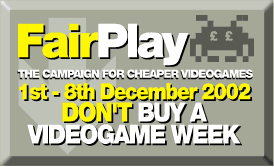|
Let's assume that a company decides to make new PS2 games and sell them not for £40, but for £10. The games will be developed to the same standard and costs as "normal" games, the only difference will be the selling price. The figures break down something like this:
X This means, to recoup development costs, the publisher has to sell 1.15million copies of the game. (Which is selling at just £10, remember.) The current userbase of the PS2 is 40 million, and growing rapidly. To recoup even above-average development costs, then, the publisher has to sell a copy of the game to just one PS2 owner in every 34 - hardly an impossible task. The only obstacle in the path of this business model is that that hardware licence fee charged by Sony, Microsoft or Nintendo is currently a flat fee rather than a percentage. That one simple change would make it perfectly viable to sell new console games at £10 rather than £40, yet with everyone still getting the same size of cut they do now. That change, from a flat-rate licence fee to a percentage one, is the change that Fair Play aims to bring about.
>>CLOSE WINDOW<<
|
||
